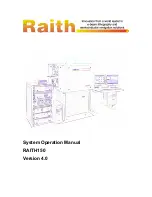
OPERATOR’S MANUAL
OPERATING TIPS AND HINTS
To achieve the best performance from your airlock keep the following in mind:
● Keep intake lines as full as possible for maximum capacity.
● Maximum capacity is achieved when using large diameter conveying lines. Only use the
smaller rubber lines for final clean-up.
● Position the airlock and route the lines to minimize the number of bends and corners. If a
corner is necessary, use a large radius elbow.
● Keep the conveying lines as short as possible to minimize friction losses.
● If long distance moving is required, use solid metal tubing whenever and wherever
possible to reduce resistance in conveying.
● If the airlock becomes jammed, use the
REVERSE
position of the airlock direction
control lever to operate the airlock in the reverse direction for a short period of time to
clear the obstruction. Alternate between the forward and reverse directions several times
until the obstruction clears. Do not reach into the airlock with your hands or any object to
clear an obstruction. If the obstruction can not be cleared through the reverse direction,
or the system is not equipped to operate in the reverse direction, the obstruction must be
manually removed as follows:
○ Shut down and lock out the power unit. If equipped, disconnect the hydraulic
system and relieve the hydraulic pressure from the airlock motor.
○ Ensure all moving components have come to a complete stop.
○ Open the access point or remove the airlock inlet or outlet connection to gain
access to the obstruction.
○ Manually remove the obstruction.
○ Check the airlock for any damage and repair or replace any components as
necessary with reference to
Section 7: Maintenance and Adjustments
.
● Keep the clearance of the rotor and blade tips within the range outlined in
Section 7:
Maintenance and Adjustments
, to maintain proper sealing and maximum efficiency.
● Keep all components properly lubricated to ensure smooth operation of the airlock.
● Keep the flexible tip wiper in good condition to maintain even flow, reduce wear rate,
prevent out-of-round casing wear, and reduce product damage.
● Keep the operating temperature of the airlock endplates below 140 °F (60 °C) for
standard airlocks equipped with “V” style seals, and below 212 °F (100 °C) for abrasive
style airlocks with “CR” seals, to prevent premature failure.
6-6
00-144476-0 A
OPERATION
Summary of Contents for Airlock 1008
Page 1: ...OPERATOR S MANUAL Airlock 1008 English 00 144471 0 A 2023 12 06...
Page 7: ...Identification of Machine AIRLOCK MODELS 1 1...
Page 9: ...Introduction AIRLOCK MODELS 2 1...
Page 15: ...Machine Configuration AIRLOCK MODELS 3 1...
Page 26: ...OPERATOR S MANUAL PAGE INTENTIONALLY LEFT BLANK 3 12 00 144473 0 A MACHINE CONFIGURATION...
Page 27: ...Safety AIRLOCK MODELS 4 1...
Page 39: ...Machine Life Cycle Procedures AIRLOCK MODELS 5 1...
Page 45: ...Operation AIRLOCK MODELS 6 1...
Page 54: ...OPERATOR S MANUAL PAGE INTENTIONALLY LEFT BLANK 6 10 00 144476 0 A OPERATION...
Page 55: ...Maintenance and Adjustments AIRLOCK MODELS 7 1...
Page 99: ...Specifications AIRLOCK MODELS 8 1...
Page 108: ...OPERATOR S MANUAL PAGE INTENTIONALLY LEFT BLANK 8 10 00 144478 0 A SPECIFICATIONS...
Page 109: ...Warranty AFTERMARKET PARTS AND SERVICE 9 1...
Page 113: ...Accessories and Attachments AIRLOCK MODELS 10 1...
Page 116: ...OPERATOR S MANUAL PAGE INTENTIONALLY LEFT BLANK 10 4 00 144480 0 A ACCESSORIES AND ATTACHMENTS...
Page 117: ...Parts List AIRLOCK 1008 MODEL 11 1...
Page 125: ...PAGE INTENTIONALLY LEFT BLANK...
















































